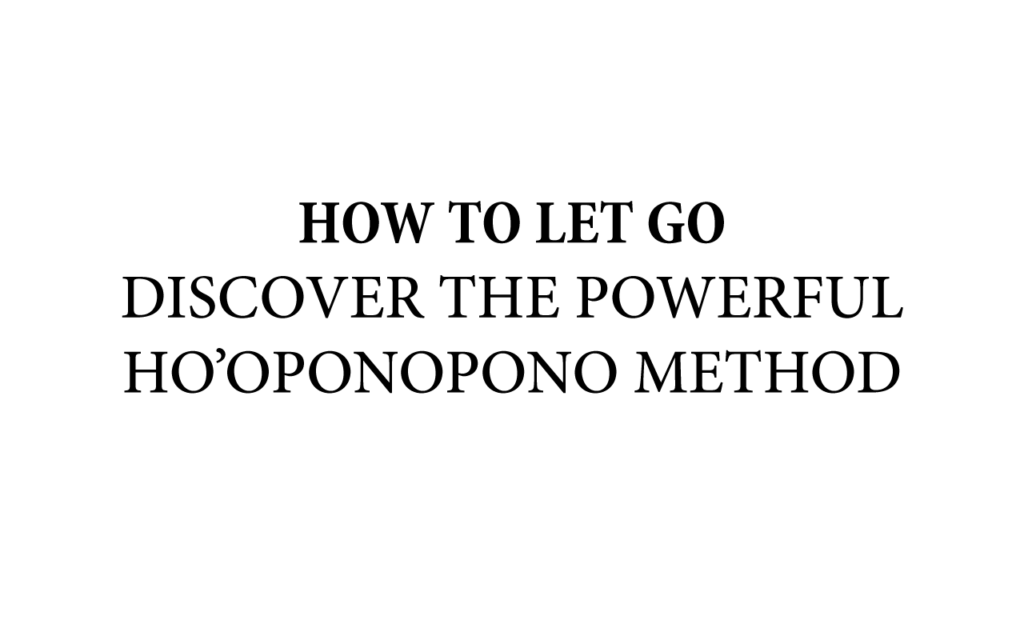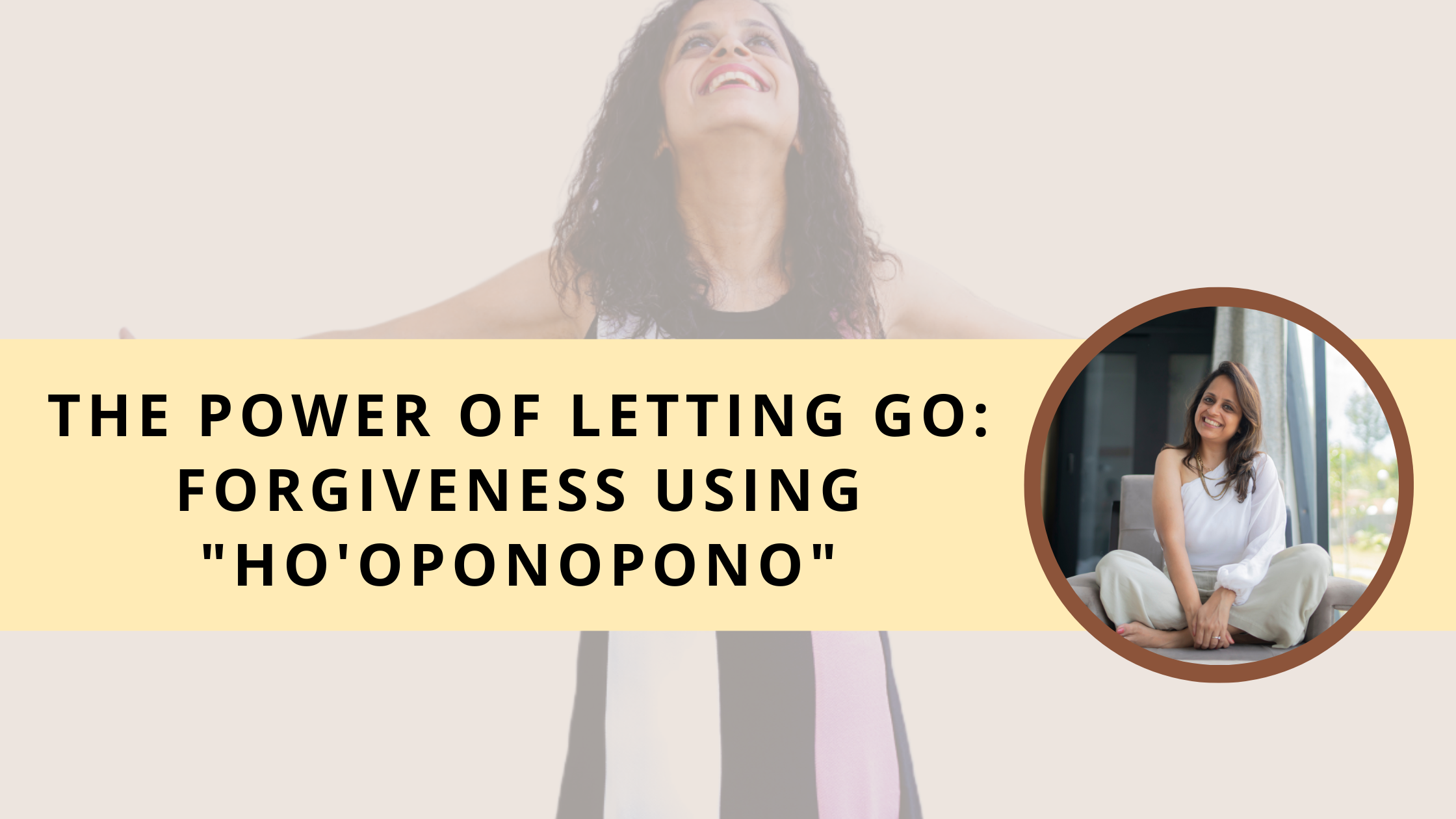In this article, we’ll explore how Ho’oponopono, an ancient Hawaiian healing practice, can assist you in releasing the heavy burden of resentment. If you’ve been holding onto grudges or unresolved anger, you’ll discover the transformative power of this method as we uncover the principles behind it. By embracing forgiveness, taking responsibility, and engaging in self-reflection, Ho’oponopono offers a path towards inner peace and liberation from the destructive force of resentment. So, let’s embark on this journey together and explore the incredible ways that Ho’oponopono can help you let go of resentment.
Understanding Ho’oponopono
Origin and meaning of Ho’oponopono
Ho’oponopono is an ancient Hawaiian practice that has been passed down through generations. The word “Ho’oponopono” itself can be broken down into “ho’o” which means “to make or cause,” and “pono” which means “right or good.” Therefore, Ho’oponopono can be translated to mean “to make things right or restore harmony.” It is a traditional method of conflict resolution and forgiveness, aimed at healing and restoring balance in relationships and within oneself.
Principles and beliefs behind Ho’oponopono
At its core, Ho’oponopono is based on the belief that everything in our lives is connected, and that any problems or conflicts we experience are ultimately a reflection of our own inner state of being. It emphasizes the importance of taking personal responsibility for our experiences and the impact we have on others. Ho’oponopono acknowledges that healing and forgiveness begin with ourselves, and that by working on our own inner healing, we can then extend that healing to others and create positive change in our relationships and environment.
How Ho’oponopono promotes forgiveness and release
Ho’oponopono offers a powerful tool for promoting forgiveness and releasing resentment. By acknowledging and taking responsibility for our own thoughts, beliefs, and actions, we can begin to let go of the resentment that may be weighing us down. Ho’oponopono teaches us that forgiveness is not about condoning someone else’s behavior or forgetting what has happened, but rather about freeing ourselves from the negative emotions and energy associated with the situation. Through the practice of Ho’oponopono, we can find healing and release from the burden of resentment.
The role of resentment in our lives
Resentment is a natural and common human emotion that arises when we feel wronged or treated unfairly. It can stem from past experiences, unresolved conflicts, or unmet expectations. However, holding onto resentment can have a detrimental impact on our mental and emotional well-being. Resentment can create a cycle of negativity, leading to increased stress, anxiety, and even physical health issues. It can also strain relationships and hinder personal growth. Understanding the role of resentment in our lives is crucial in order to address and release it effectively.
Recognizing Resentment
Defining resentment
Resentment can be described as a deep-seated feeling of anger, bitterness, or indignation towards someone or something that has caused harm, disappointment, or injustice. It is often accompanied by a sense of injustice and a desire for revenge or retribution. Resentment can stem from various sources, such as past traumas, unresolved conflicts, or unfulfilled expectations. It is important to recognize and acknowledge resentment in ourselves in order to begin the healing process.
Identifying the signs and symptoms of resentment
Resentment can manifest in a variety of ways, both emotionally and physically. Emotionally, it may be characterized by feelings of anger, irritability, frustration, or sadness. It can also lead to a sense of powerlessness or victimhood. Physically, resentment may result in increased stress levels, sleep disturbances, digestive issues, or even chronic pain. By paying attention to these signs and symptoms, we can become more aware of our own resentment and take steps towards resolving it.
Understanding the impact of resentment on mental and emotional well-being
Holding onto resentment can have a profound impact on our mental and emotional well-being. It can create a constant state of negativity, leading to increased stress, anxiety, and even depression. Resentment can also hinder our ability to form healthy and fulfilling relationships, as it often involves harboring grudges and holding onto past grievances. Moreover, the energy spent on resentment could be better used for personal growth and self-care. Recognizing the detrimental effects of resentment is essential in order to seek ways to release it and cultivate a healthier mindset.

The Ho’oponopono Process
Clearing the mind and opening the heart
The Ho’oponopono process begins with clearing the mind and opening the heart to allow for healing and forgiveness. This can be done through various techniques, such as meditation, deep breathing, or simply taking a moment to quiet the mind and tune into the present moment. By creating a calm and receptive state, we can better connect with our inner selves and begin the process of forgiveness and release.
The four key phrases of Ho’oponopono
Ho’oponopono utilizes four key phrases that are repeated as mantras during the practice. These phrases are: “I’m sorry, please forgive me, thank you, I love you.” Each phrase carries a specific intention and power, contributing to the process of healing and releasing resentment. “I’m sorry” acknowledges our own role in the situation and expresses regret. “Please forgive me” is a plea for forgiveness and an acceptance of our own imperfections. “Thank you” expresses gratitude for the opportunity to heal and transform. “I love you” represents the unconditional love and compassion we extend to ourselves and others.
Practical techniques for practicing Ho’oponopono
Practicing Ho’oponopono can take many forms, depending on individual preferences and circumstances. Some techniques include writing down the four key phrases repeatedly, creating a Ho’oponopono altar or sacred space, or incorporating the phrases into daily meditation or mindfulness practices. It is important to find a technique that resonates with you personally and to establish a regular practice in order to facilitate the healing and release of resentment.
Healing Through Forgiveness
How forgiveness contributes to letting go of resentment
Forgiveness is an integral part of the Ho’oponopono process and plays a crucial role in letting go of resentment. When we forgive, we release ourselves from the emotional burden associated with the resentment. Forgiveness allows us to free ourselves from the cycle of anger and negativity, creating space for healing and growth. It is important to note that forgiveness does not mean forgetting or condoning the actions of others, but rather choosing to no longer allow those actions to define our own inner state.
Steps to forgiving oneself and others
Forgiving oneself and others can be a challenging process, but it is essential for releasing resentment and finding peace. The first step is acknowledging and accepting the pain and emotions associated with the situation. This may involve allowing ourselves to feel anger, sadness, or betrayal. The next step is shifting our perspective and choosing to let go of the resentment, recognizing that holding onto it only perpetuates our own suffering. This can be followed by expressing forgiveness, either in writing or through a heartfelt conversation, and consciously releasing the negative emotions tied to the resentment.
The transformative power of self-reflection and acceptance
Self-reflection and acceptance are key components of the forgiveness process. By examining our own role and responsibility in the situation, we can gain insight and understanding, facilitating forgiveness. Self-reflection involves honestly looking at our own thoughts, beliefs, and actions, and taking responsibility for the impact we have on others. Acceptance, on the other hand, involves embracing the imperfections and vulnerabilities of ourselves and others. Through self-reflection and acceptance, we can experience profound transformation and growth, ultimately leading to the release of resentment.

Releasing Resentment with Ho’oponopono
Cultivating compassion and empathy
Cultivating compassion and empathy is an integral part of the Ho’oponopono practice for releasing resentment. By developing a deeper understanding of others’ perspectives and motivations, we can begin to soften our own hearts and release the grip of resentment. It is important to remember that everyone makes mistakes and carries their own pain, and that compassion and empathy can help break the cycle of resentment and promote healing within ourselves and our relationships.
Using Ho’oponopono to untangle toxic emotions
Ho’oponopono offers a powerful framework for untangling toxic emotions associated with resentment. By consistently practicing the four key phrases, we confront and address the toxic emotions that have been deeply ingrained within us. The process of consistently repeating the phrases allows for a deep exploration of the emotions, gradually unraveling and releasing their hold on us. This practice also helps us take ownership of our emotions and empowers us to transform them into positive energy.
Letting go of grudges and grievances through the practice of Ho’oponopono
Through the practice of Ho’oponopono, we can learn to let go of grudges and grievances that have been weighing us down. By acknowledging our part in the conflict or situation, expressing genuine remorse, and showing gratitude for the opportunity to heal, we can gradually release the negative emotions associated with the resentment. Ho’oponopono reminds us that holding onto grudges only perpetuates our own suffering, and that true freedom and healing come from forgiveness and release.
Benefits of Ho’oponopono for Resentment Release
Reduced stress and anxiety
Releasing resentment through the practice of Ho’oponopono can have a significant impact on reducing stress and anxiety levels. By letting go of the negative emotions associated with resentment, we create space for inner peace and emotional well-being. The practice of Ho’oponopono promotes a shift in mindset, allowing us to focus on self-care and personal growth rather than dwelling on past grievances. This shift in perspective leads to a reduction in stress and anxiety, as we learn to navigate conflicts and challenges with a sense of calm and acceptance.
Improved relationships and communication
Practicing Ho’oponopono can have a positive ripple effect on our relationships and communication. By releasing resentment and embracing forgiveness, we create a more harmonious and authentic connection with others. The practice of Ho’oponopono encourages open and honest communication, as it fosters a sense of empathy, compassion, and understanding. By addressing and resolving underlying conflicts and resentments, we can build stronger and healthier relationships based on trust and mutual respect.
Enhanced emotional well-being and inner peace
One of the greatest benefits of practicing Ho’oponopono for resentment release is the enhancement of emotional well-being and the cultivation of inner peace. By letting go of the burdens of resentment, we open ourselves up to experiencing more joy, gratitude, and contentment. The practice of Ho’oponopono creates a sense of inner harmony and balance, allowing us to navigate life’s challenges with a greater sense of calm and resilience. Ultimately, the release of resentment leads to enhanced emotional well-being and a deeper connection with our true selves.

Integrating Ho’oponopono Into Daily Life
Incorporating forgiveness and gratitude practices
A key aspect of integrating Ho’oponopono into daily life is incorporating forgiveness and gratitude practices into our routines. This can involve starting or ending each day with a gratitude journal, expressing appreciation for the people and experiences in our lives. Additionally, taking regular moments throughout the day to practice forgiveness, either through silent reflection or using the four key phrases of Ho’oponopono, can help maintain a mindset of compassion and release.
Creating a sacred space for emotional healing
Creating a sacred space for emotional healing is another way to integrate Ho’oponopono into daily life. This can involve setting aside a specific area in your home dedicated to the practice of Ho’oponopono, with objects or symbols that hold personal significance. This space can serve as a reminder and sanctuary for forgiveness, release, and personal growth. By intentionally using this space for reflection, meditation, or the repetition of the key phrases, you can cultivate a deeper connection to the practice and its transformative power.
Maintaining consistent Ho’oponopono practice for long-term results
Consistency is key when integrating Ho’oponopono into daily life. Like any practice, the benefits are more likely to be experienced over time with consistent effort. By making Ho’oponopono a part of your daily routine, you can gradually cultivate a mindset of forgiveness, release, and inner peace. This can be done by setting reminders, establishing specific times for practice, and creating accountability systems, such as partnerships or support groups. With commitment and consistency, the long-term results of Ho’oponopono can be transformative and life-changing.
Overcoming Challenges and Resistance
Addressing resistance to forgiveness and letting go
Resistance to forgiveness and letting go is a common challenge that many individuals face when practicing Ho’oponopono. It can be difficult to release resentment, especially when the pain or injustice feels deeply ingrained. However, it is important to remember that forgiveness is a process, and it is okay to feel resistance. One way to address this resistance is through self-compassion and patience. By acknowledging and accepting our own emotions and limitations, we can gradually open ourselves up to the possibility of forgiveness and release.
Dealing with deep-rooted resentments
Deep-rooted resentments can present a unique challenge in the practice of Ho’oponopono. These resentments may be tied to past traumas, significant relationships, or long-standing conflicts. Dealing with such resentments requires deep self-reflection, self-awareness, and potentially the support of a trained therapist or counselor. In these situations, it is essential to approach the practice of Ho’oponopono with gentleness and self-care, seeking professional help when necessary. Working through deep-rooted resentments takes time and patience, but with the right support, healing and release are possible.
Seeking support from practitioners and community
Seeking support from practitioners and community can greatly enhance the process of Ho’oponopono and the release of resentment. Connecting with others who are also on the path of forgiveness and healing can provide validation, encouragement, and guidance. Practitioners or mentors who are familiar with the practice of Ho’oponopono can offer insights and tools to navigate challenges and provide a safe space for personal growth. Additionally, participating in workshops, support groups, or online forums can create a sense of community and accountability, further facilitating the process of resentment release.

Case Studies and Personal Experiences
Real-life examples of individuals benefiting from Ho’oponopono
Real-life examples of individuals benefiting from Ho’oponopono abound, showcasing the transformative power of this practice. Stories of individuals who have let go of deep-rooted resentment and experienced profound healing are abundant. These individuals have found peace, restored relationships, and experienced personal growth through the practice of Ho’oponopono. Their stories offer hope and inspiration to those seeking to release their own resentment and find emotional well-being.
Success stories of resentment release and healing
Success stories of resentment release and healing through Ho’oponopono are truly inspiring. These stories highlight the profound impact that the practice can have on individuals’ lives. People who have practiced Ho’oponopono have reported reduced stress and anxiety levels, improved relationships, and a greater sense of inner peace and well-being. These success stories serve as a reminder of the transformative potential of forgiveness and the power of Ho’oponopono to facilitate healing and personal growth.
Lessons and insights gained from personal experiences
Personal experiences of practicing Ho’oponopono offer valuable lessons and insights that can guide others on their own journeys of resentment release and healing. Individuals who have embraced the practice have discovered the importance of self-compassion, self-reflection, and acceptance. They have learned that forgiveness is a choice, and that it ultimately brings peace to both themselves and those they forgive. Personal experiences also highlight the ongoing nature of the practice, emphasizing the need for consistency and commitment in order to achieve lasting results.
Combining Ho’oponopono with Other Healing Modalities
Exploring complementary practices for holistic growth
Ho’oponopono can be combined with other healing modalities to enhance holistic growth. Practices such as meditation, mindfulness, affirmations, or energy healing techniques can complement Ho’oponopono, providing additional support for emotional healing and release. These complementary practices can help cultivate a sense of self-awareness, self-care, and deepen the connection to one’s inner wisdom. Exploring different healing modalities and finding the right combination can contribute to a comprehensive and transformative healing journey.
Integrating Ho’oponopono with mindfulness, meditation, or therapy
Integrating Ho’oponopono with mindfulness, meditation, or therapy can offer a multi-faceted approach to resentment release and emotional healing. Mindfulness and meditation practices can help cultivate awareness and present-moment focus, allowing for a deeper exploration of emotions and thoughts. Therapy, on the other hand, provides a safe and supportive environment to address underlying emotions and conflicts. By combining these modalities with Ho’oponopono, individuals can access different tools and perspectives, creating a more holistic and effective healing process.
Finding the right combination of techniques for personal healing
Finding the right combination of techniques for personal healing is a unique and individual journey. Each person may resonate with different modalities and practices, and it is important to honor one’s own intuition and preferences. Some individuals may find that a combination of Ho’oponopono, mindfulness, and therapy works best for them, while others may prefer to explore meditation or energy healing. Experimenting with different modalities and techniques allows individuals to discover what resonates with them personally and supports their unique healing journey.
In conclusion, Ho’oponopono offers a powerful framework for releasing resentment and promoting emotional healing. Through the practice of acknowledging responsibility, expressing remorse, and cultivating forgiveness, individuals can let go of grudges and grievances, fostering improved relationships, reduced stress, and enhanced emotional well-being. Integrating Ho’oponopono into daily life requires consistency and commitment, but the transformative effects are profound and long-lasting. By combining Ho’oponopono with other healing modalities, individuals can access a comprehensive approach to resentment release and personal growth. Ultimately, the practice of Ho’oponopono empowers individuals to take ownership of their emotional well-being, foster compassion and empathy, and cultivate inner peace.

